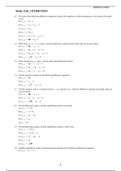Answers
Apm1514 with a lot of practise questions per study units and solutions. Some of these questions have come up in numerous old exams and if you do all the questions it's a guarantee 80%
- Institution
- University Of South Africa (Unisa)
Ap1514 with a lot of practise questions with solutions. It has come up in numerous old exam papers or the same questions with only numbers that changed. A must have to get a distinctions
[Show more]



